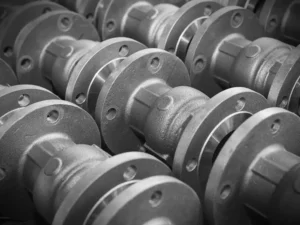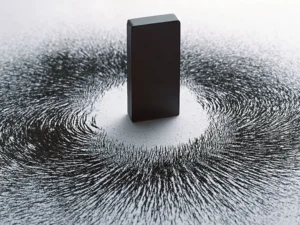Is stainless steel magnetic? This question has many answers, just like this material has many types. You might have heard that stainless steel is magnetic due to the presence of copper. This is right and wrong at the same time. Confused? I bet you are!
This is why this question needs an explanatory answer. Stainless steel exhibits both magnetic and non-magnetic behavior depending on its type. Two main factors influence its magnetism. Let’s kick things off and understand this material and its magnetic behavior.
Overview of Stainless Steel & Magnetism

Stainless steel is not a single element but an alloy of different metals. Those are chromium, iron, carbon nickel, and magnesium. The presence of chromium makes it rust-proof. The small proportion of carbon is good enough to make it hard. It is one of the most widely used metals due to its capability to fight against rust.
It contains more than 10.5% chromium, which makes it stand out. Some types of stainless steel contain an even higher proportion of chromium. When stainless steel comes in contact with oxygen, chromium forms an oxide layer. This layer is handy as it protects it from rusting. Let’s have a brief overview of magnetism.
Have you ever seen a metal piece sticking with a magnet? This happens due to magnetism. The main culprits are the electron spin and the atoms’ arrangement within the metal. As you know, electrons have spin. Metals have many electrons which revolve around the nucleus. The spin of individual electrons combines and makes a significant magnetism.
If the arrangement of the atoms does not support this spin, then there is no magnetism. Different types of stainless steel differ from each other. They have varied arrangements of atoms, such as FFC, BCC, and so on. In the coming section, we will discuss the magnetic behavior of this material.
Is Stainless Steel Magnetic?

Yes, and No! There are different types of stainless steel. Each of them varies in terms of their magnetism. For example, ferritic and martensitic stainless steel exhibit magnetism. On the flip side, the austenitic stainless steel does not show any magnetic behavior. This is due to their differences in atomic arrangement.
As I said earlier, the arrangement of atoms is critical for magnetism. Each metal consists of numerous atoms. Each atom consists of electrons that revolve around the nucleus. Each electron has its spin (which produces a small magnetic field). As atoms have many electrons, their collective spin makes a significant impact.
This collective spin of an electron produces magnetism. However, the arrangement of the atoms acts as a hurdle. Some stainless steel has a very organized structure of atoms. The atoms in such types remain closely packed together. So, they don’t support and cancel the collective spin of electrons.
As a result, no magnetism happens. Austenitic stainless steel is an example. On the flip side, some types of stainless steel don’t have organized structure atoms. They remain loosely held together. So, they support the spin and do not alter their direction of spin. As a result, the electron spin produces magnetism.
Ferritic stainless steel is an example of magnetic behavior. Remember, metal atoms are arranged in a specific geometry called a crystal. These crystals define whether a metal is magnetic or non-magnetic. A metal with very organized atoms would be non-magnetic, and vice versa.
Types of Stainless Steel & Their Magnetism
I won’t let you go merely by explaining stainless magnetism. Some types of stainless steel behave differently when near a magnet. Let’s jump down and discuss those types and their magnetic characteristics.
1- Austenitic Stainless Steel
This stainless steel is famous for its corrosion resistance. It has very high chromium along with other alloy elements. So, it can easily make chromium oxide when in moist conditions, preventing rusting. Moreover, it is non-magnetic stainless steel. But the question is: WHY?
This category of stainless steel has FCC (Face Centered Cubic) atom structures. The atoms are held together closely and organized very well. So, they can easily cancel the spin or magnetic field produced by their electrons. As a result, there is no magnetism. When such an alloy goes near a magnet, it doesn’t show any movement. 304 and 316 stainless steel are the examples.
2- Ferritic Stainless Steel
This type of stainless steel is inexpensive. It is less corrosion-resistant than austenitic steel. These metals are magnetic and can stick to nearby magnets. The reason is that they have a BCC (Body Centered Cubic) Crystal or atom arrangement.
In such metals, the electrons spin, or small magnetic fields are not canceled out. The atoms are loosely held. So, the magnetic field produced by electrons spinning succeeds in aligning. As a result, this metal becomes magnetic. It sticks to the magnet. Stainless steel of grades 430 and 409 are examples.
3- Martensitic Stainless Steel
This metal has a high carbon content, along with iron, chromium, and nickel. Due to this, it is very hard. However, unlike austenitic stainless steel, it is magnetic. Its properties are similar to those that exhibit magnetism. Interestingly, it has an atomic arrangement similar to ferritic stainless steel.
You may wonder if they fall in the ferritic stainless steel category. But that is not true, as they have their unique category. Upon instant cooling, their electronic arrangement gets disturbed. So, their crystal changes from BCC to BCT, which is body-centered trigonal. Their arrangement of atoms does not cancel the collective spin of electrons.
As a result, the spin of those electrons aligns and causes a significant magnetic field. So, the metal becomes magnetic. The question is: how are they cooled to change their structures? These stainless steel are hard and undergo heating. During heating, the steel manufacturer puts them on cooling immediately. As a result, their structures get disturbed.
Additional Point: This sudden cooling during the heat process is called quenching. This transformation from very high temperature to low temperature is critical. It causes disorder in the structures of these metals. Their examples include 410 and 420.
4- Duplex Stainless Steel
This is a unique type of stainless steel that has a different atomic structure. Its characteristics are a blend of austenitic and ferritic stainless steels. The reason is that its atom microstructure has both FCC and BCC crystal arrangements. Some of the atoms are centered in a cubic arrangement. This phase prevents the magnetic properties of these metals.
However, some of their atomic portions have body-centered cubic arrangements or structures. So, this portion, like ferrite metal, supports magnetic behavior. The spin of electrons can align, producing a metal’s magnetic nature. These types of stainless steel are made through the heating process.
Are you thinking about their mechanical properties? They are similar to austenitic and ferritic stainless steel. They are strong, corrosion and fatigue-resistant. Above all, their prices are not too high, which is a big plus. The manufacturer produces these metals to meet particular requirements in their projects. Their examples include grades 2205 and 2507.
5- Precipitation-Hardened Stainless Steel
These stainless steels are similar to martensitic types. There is one key aspect to understand. These steels are produced through heating and then cooling. So, their microstructures shift from BCC to BCT due to heating and cooling. The transportation from BBC to BCT is similar to that of martensitic stainless steel. As far as their magnetism is concerned, they are magnetic. When placed near a magnet, they show some movement of attraction.
Why is Magnetism Important in Stainless Steel?

Stainless steel’s magnetic behavior is helpful in many ways. First, this property is excellent for identifying different materials. You can identify various types of stainless steel by using a magnet. For this, you will put a magnet close to the piece. If it is attracted to a magnet, it will be ferritic or martensitic stainless steel.
Keep in mind that each stainless steel has its unique properties. For example, austenitic stainless steel has high chromium and is rust-proof. On the flip side, the rust-proofing of ferritic stainless steel is slightly compromised. Manufacturers use a magnetic feature to assess stainless steel. This helps them understand its characteristics and types.
In the end, the manufacturers choose the suitable material for products. Moreover, some applications involve the magnetic behavior of stainless steel. For example, the components of sensors and electrical systems use stainless steel. Those products utilize the magnetic behavior of this metal. So, magnetism plays a crucial role in the application and usability of this material.
Factors that Affect the Magnetism of Stainless Steel
The magnetic nature of stainless steel, in one way or another, is linked with many other factors. Those facets can affect the magnetic properties of all the types. Here is the list of the prominent factors that affect the magnetism of stainless steel:
- Composition
- Welding and Fabrication
- Heating and Cooling Process
- Atomic arrangement (microstructure)
- The presence of unpaired electrons in orbital
If stainless steel has a high nickel content, it will be non-magnetic. Similarly, heating and sudden cooling can also alter magnetic properties. Atomic arrangement and electron spins are the most fundamental factors. Metal with an organized structure of atoms will be non-magnetic, and vice versa.
Frequently Asked Questions
Do magnets stick to real stainless steel?
It depends on the type of stainless steel. Magnets don’t stick with some types of stainless steel, such as austenitic steel. However, ferritic and martensitic steels will stick to magnets. These types of steels are magnetic due to the loose packing of electrons.
Which stainless steel is most magnetic?
Ferritic stainless steel is considered the most magnetic due to its body-centered atoms. Moreover, their losing packing of atoms further supports their magnetism. Their examples include stainless steel for grades 430 and 409.
How do you identify stainless steel at home?
Identifying stainless steel is easy. You can do it by bringing a magnet close to the metal piece. If the piece moves towards the magnet and sticks to it, it is ferritic or martensitic stainless steel. If it does not stick, it is austenitic stainless steel.
Conclusion
Stainless steel is a well-known material in manufacturing industries. Its excellent rust protection and strength make it stand out. However, their behavior against magnets seems to confuse people. There is none of their error; instead, stainless steel has many behaviors.
There are different types of stainless steel, and each behaves differently. For example, austenitic stainless steel is not magnetic, but ferritic is. One thing that is common in all of those types is corrosion resistance and strength. This guide covers all things related to stainless steel.
